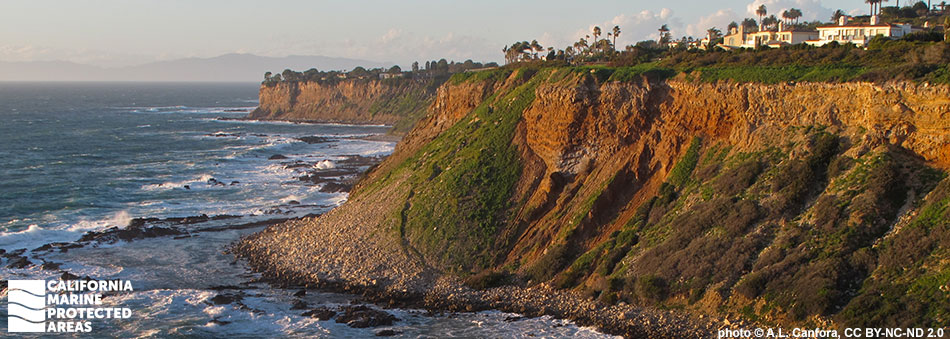
Overview
Point Vicente State Marine Conservation Area (SMCA) (No-Take) and Abalone Cove State Marine Conservation Area (SMCA) are adjacent marine protected areas (MPAs) located along the coast of Palos Verdes, roughly 20 miles south of Santa Monica and the greater Los Angeles area. Spanning nearly three miles of coastline, the coves, beaches, bluffs, and coastal trails in and around these MPAs provide many opportunities for recreation including spending time at the beach, hiking, surfing, diving, and whale watching.
Point Vicente SMCA (No-Take), together with the adjacent Abalone Cove SMCA form an almost 20 square mile contiguous protection zone. Point Vicente SMCA (No-Take) encompasses more than 15 square miles of kelp forests, sandy beaches, rocky reefs, hard and soft seafloor habitats that reach depths greater than 2,600 feet, and rocky intertidal areas. Many species thrive in these MPAs, including garibaldi, California sheephead, and California spiny lobster.
Abalone Cove SMCA encompasses nearly five square miles of rocky shoreline, sandy beaches, surfgrass beds, kelp forests, and sandy and rocky seafloor habitats that reach depths greater than 2,200 feet. The MPA's quiet tidepools protect California spiny lobsters, sea urchins, and other rocky tidepool inhabitants, and provide structure for surfgrass beds. The Palos Verdes Peninsula juts out to sea close to a deepwater offshore basin, making Point Vicente SMCA (No-Take) and Abalone Cove SMCA a mix of nearshore and offshore ecosystems.
Regulations
Point Vicente SMCA (No-Take)
It is unlawful to injure, damage, take, or possess any living, geological, or cultural marine resource. Take incidental to certain permitted activities may be allowed. Other restrictions may apply. See CCR T14 §632(b) (link below) for details.
California Code of Regulations Title 14, Section 632(b)(119)(opens in new tab)
Abalone Cove SMCA
It is unlawful to injure, damage, take, or possess any living, geological, or cultural marine resource, EXCEPT:
Recreational take of market squid by hand-held dip net, and white seabass and pelagic finfish (northern anchovy, barracudas, billfishes, dorado (dolphinfish), Pacific herring, jack mackerel, Pacific mackerel, Pacific sardine, blue shark, salmon shark, shortfin mako shark, thresher shark, swordfish, tunas, Pacific bonito, and yellowtail) by spearfishing is allowed.
Commercial take of coastal pelagic species (northern anchovy, Pacific sardine, Pacific mackerel, jack mackerel, and market squid) by round-haul net, brail gear, and light boat is allowed. Not more than five percent by weight of any commercial coastal pelagic species catch landed or possessed shall be other incidentally taken species. Commercial take of swordfish by harpoon is allowed.
California Code of Regulations Title 14, Section 632(b)(120)(opens in new tab)
Quick Facts
Point Vicente SMCA (No-Take)
MPA size: 15.04 square miles
Shoreline span: 1.40 miles
Depth range: 0 to 2,640 feet
Habitat composition*:
- Sand/mud: 14.76 square miles
- Rock: 0.68 square miles
Abalone Cove SMCA
MPA size: 4.79 square miles
Shoreline span: 1.5 miles
Depth range: 0 to 2,237 feet
Habitat composition*:
- Sand/mud: 4.53 square miles
- Rock: 0.51 square miles
*Habitat calculations are based on three-dimensional area and may exceed the total MPA area listed above.